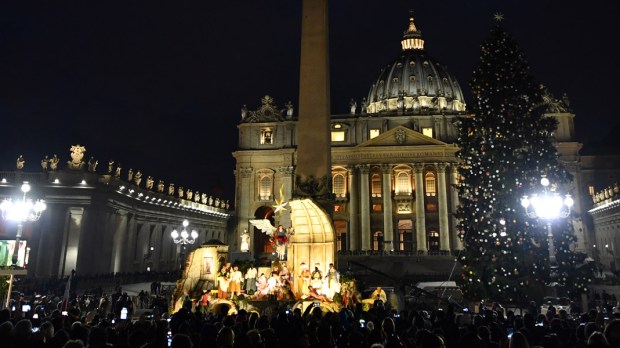Like any country, Vatican City has its very own “national” Christmas traditions. Unlike other countries, these traditions are meant to reinforce the Christmas celebrations of more than one billion people around the world. What are some of these traditions?
In 1982, St. Pope John Paul II decided to bring two popular symbols of Christmas to St. Peter’s Square: the Nativity scene and a giant tree.
The Nativity scene as we know it was introduced by St. Francis of Assisi. Searching for a way to capture the attention of his followers and have them truly connect with the meaning of Christmas, he recreated the scene of the Holy Family in the stable, with some of his own disciples and live animals.
Out of St. Francis’ Nativity scene the idea of having a creche made up of statues instead of real people took off, and soon throughout Italy different schools of Nativity scene artistry developed.
Centuries later, most every Christian family has a Nativity scene in their home, and Pope John Paul II decided his home — the Vatican — should have one too.
Since then different countries and regions of Italy have taken turns donating a Nativity scene to the Vatican. The 2017 nativity scene was donated by the Abbey of Montevergine, a Benedictine Abbey and Marian sanctuary located near Naples.
The Christmas tree that stands next to the Nativity scene is also donated by a country or region. The 2017 tree was donated by Poland.
Every year in early December there is an official ceremony to unveil the Nativity scene and light the tree. Delegates representing the donor country or region make brief speeches about their donation and the Vatican Gendarmerie Band plays a selection of traditional Advent and Christmas tunes.
The tree and Nativity scene stay up in the piazza until the Feast of the Baptism of the Lord.
Kids and the pope
Many Romans set up Nativity scenes in their own homes. The children of Rome actually have a standing appointment with the pope on the Third Sunday of Advent to have the central figure of their Nativity scene, baby Jesus, blessed by the pope.
Roman oratories, parish centers that offer programs for children, and the children who use the St. Martha Pediatric Dispensary in Vatican City make a pilgrimage to St. Peter’s Square on Gaudete Sunday to be present when the pope leads the Angelus. After the traditional midday prayer is said, the children raise their “bambinelli” and the pope blesses them from his window. The children then take home their blessed figures of Jesus to be placed in their Nativity scene at home on December 24.
Before Christmas Eve the papal schedule includes a couple of important annual audiences. The Holy Father meets with the cardinals who live and work at the Vatican — the Roman Curia — and the employees of Vatican City State.
The two audiences are traditionally pleasant encounters where the pope gets a chance to thank everyone for their hard work during the year.
The apex of the Vatican’s Christmas traditions is, of course, midnight Mass on Christmas Eve night.
Until 2008 the pope would celebrate Mass at midnight as December 24 became December 25. In 2009 Pope Benedict XVI, who was 81 years old at the time, had the Vatican move the time up a couple of hours as it was getting difficult for him to celebrate Mass so late at night.
The figure of the baby Jesus is placed in front of the altar for the Mass. As he processes out at the end of the celebration, the pope picks up the figure and — accompanied by a group of children — carries the baby Jesus to the Nativity scene set up in the entrance of St. Peter’s Basilica.
The next morning the pope celebrates Christmas Day Mass privately and appears on the central balcony of St. Peter’s to give the “Urbi et Orbi” blessing, or his blessing “to the city and the world.”
12 days of Christmas
Christmas winds down at the Vatican with the pope celebrating back-to-back Masses on January 6 for the Feast of the Epiphany and January 7 for the Feast of the Baptism of the Lord.
There is one twist to the Mass for the Baptism of the Lord: the Mass is celebrated in the Sistine Chapel and the Holy Father usually baptizes the babies of Vatican City employees who were born in the last few months.

